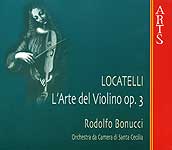Listening to Locatelli’s four-hour-plus magnum opus L’Arte del Violino (The Art of the Violin) can be something of an ordeal. The 12 concertos are not particularly distinguished–all are melodically simple and based on Corellian models with occasional (and not very imaginative) stylistic nods to Vivaldi. However, in Locatelli’s plan the orchestral writing mattered little since it essentially serves only as a foil to bookend the 24 notated solo caprice-cadenzas (one in each concerto’s first and third movements) designed to demonstrate the soloist’s extreme virtuoso ability. The capricci become more difficult as the concertos’ numeric order progresses, culminating with the cycle’s only subtitled part, “Il laberinto armonico–Facilis aditus, difficilis exitus” (Harmonic Labyrinth–Easy to enter; difficult to escape), in the 12th concerto’s final Allegro.
The truth is, unlike the programmatic variety that characterizes music of the Northern school, or the rhythmically charged dynamism found in Vivaldi and Tartini, Locatelli’s brand of virtuosity rarely transcends a surface-level “difficulty for difficulty’s sake”. And while many observers regard L’Arte del Violino as Locatelli’s most famous work, it’s an anomaly within his oeuvre and certainly unrepresentative of his prodigious and creative skill as a composer.
For the most part, violinist Rodolfo Bonucci does an excellent job negotiating Locatelli’s often-harrowing technical challenges. There are a few minor intonation problems, but on the whole he delivers respectably driven, stylish performances. However, the major drawback of this set is the sound. The strings sound unnaturally homogenous, and together lack both clarity and depth. The acoustic context of Bonucci’s solos is inconsistent, which may be the result of multiple takes and/or editing irregularities.
For many violinists L’Arte del Violino has been and remains a veritable Mount Everest of the literature. Though suffering somewhat from its own sonic shortcomings, Susanne Lautenbacher’s early-1960s mono cycle (Vox Box) has stylistically and musically held up well over the years. Mela Tenenbaum (Essay) and Elizabeth Wallfisch (Hyperion) also offer worthy cycles on par with or exceeding Bonucci’s. However, for unparalleled virtuosity and sheer sonic splendor, Mariana Sirbu with I Musici on Philips remains the set of choice.
































